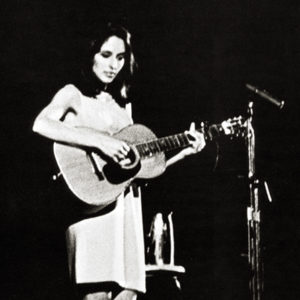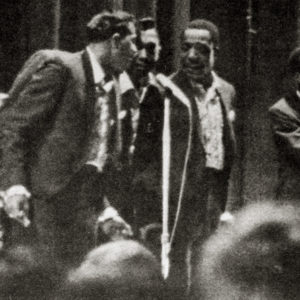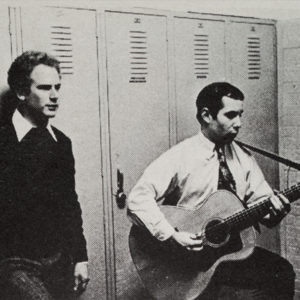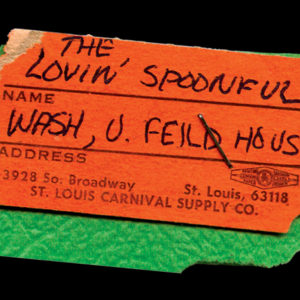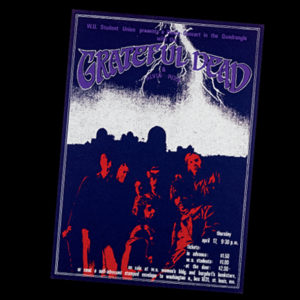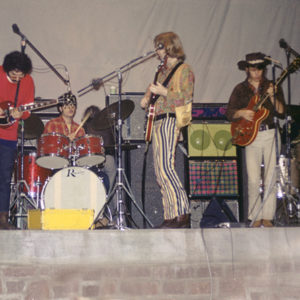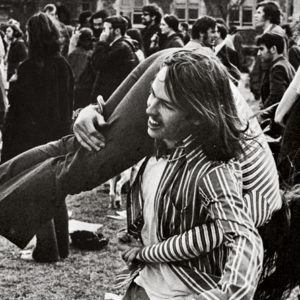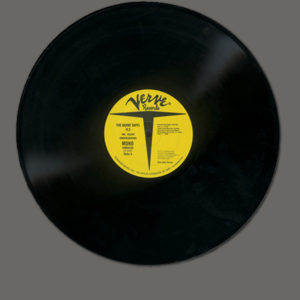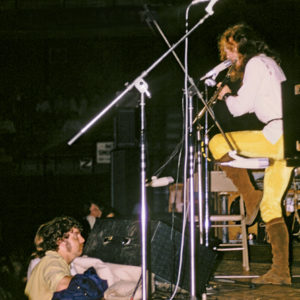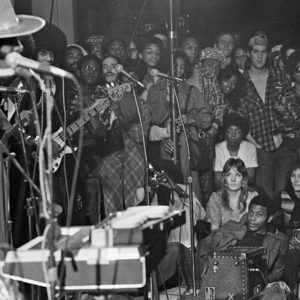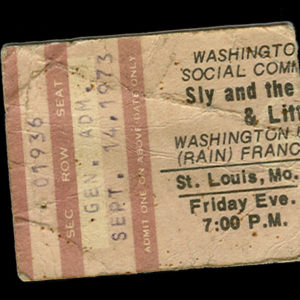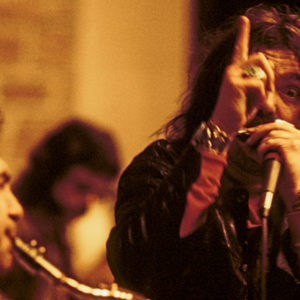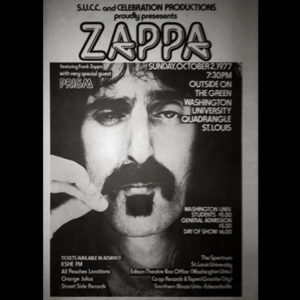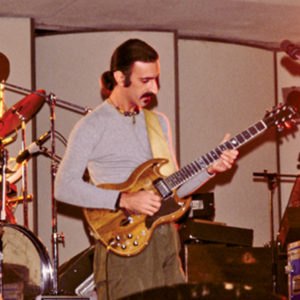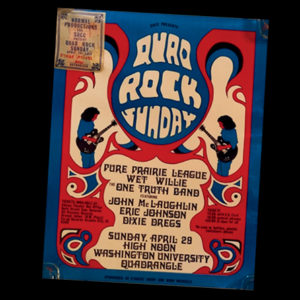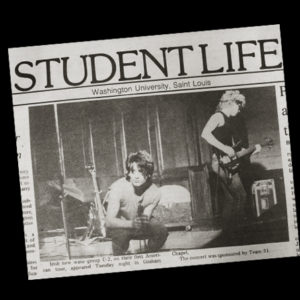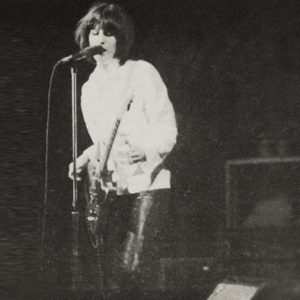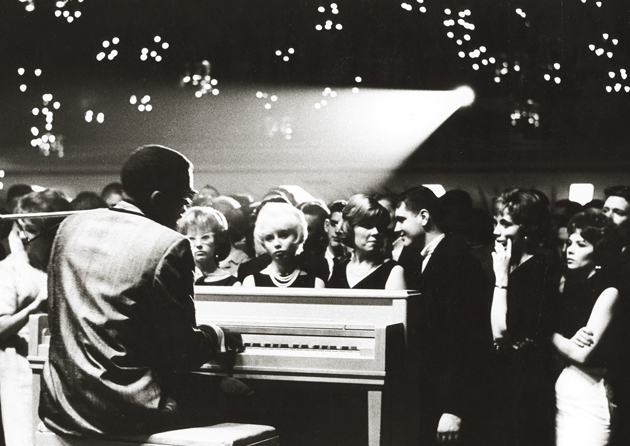
In 2011, U2, one of the world’s most popular bands, played to a sold-out crowd of more than 50,000 in St. Louis’ Busch Stadium. But it was 30 years earlier when the band played St. Louis for the first time at Washington University’s Graham Chapel.
On April 7, 1981, U2 — hired for the sum of $750 — performed to a capacity crowd, playing songs off their newly released, now-classic album Boy.
At the time, the band was being hyped as the next Who or Led Zeppelin, which couldn’t have been further from the truth. Instead, those in attendance were witnessing the early stage of a band that would become one of the world’s most well-known musical acts, with future hits including “Where the Streets Have No Name,” “One,” “Sunday Bloody Sunday,” and “Pride (in the Name of Love).”
Former St. Louis Post-Dispatch music critic and Euclid Records employee Steve Pick attended the show and got to meet the band afterward to interview them. “The main thing I remember is it was the first time I’d ever heard of Guinness beer, because they insisted on having Guinness,” Pick says.
Peter Steinberg, AB ’81, recalls attending U2’s sound check in Graham Chapel (standing in the back of an empty chapel, amazed, while the band played “I Will Follow”) and meeting guitarist The Edge and bassist Adam Clayton. He accompanied them over to campus radio station KWUR-FM for an interview, where a group of KWUR staffers crowded around to ask their questions as well.
That evening, U2 performed to a wildly enthusiastic crowd. Bono remarked at one point: “We’re called U2. We’ve come a long way, meaning in distance that is. This is a very nice place you have here.”
Mary Connelly, BFA ’83, an associate professor of visual arts at the University of Colorado–Denver, looks back on that evening: “It was amazing to see them in such a small space. More than anything, I remember my eyes were glued on Bono for the entire concert. He had such an incredible presence and totally stole the show!”
Tom Lambrecht, AB ’83, recollects, “They were definitely still learning their chops and bore little resemblance to the band that now struts its stuff in coliseums.”
“Afterward, I talked my way backstage,” recalls Steinberg, “and mistook Larry Mullen for Bono (their haircuts were similar at the time), but he was very gracious about it.” He adds, “They didn’t act like superstars. They were still four regular guys from Dublin; you could talk to them about anything.”
Over the years, Washington University students have seen bands that, much like themselves, were on their way to greater success. Nationally recognized acts, many in their prime, also made the campus a stop on their tours. Concerts have often taken place in the Field House or in Brookings Quadrangle. Graham Chapel also has been a frequent concert venue, and later the Gargoyle established an on-campus music club atmosphere for students to enjoy bands. Moreover, students organized these celebrated events, which is a tradition that continues today. The following recounts a few of the memorable moments.
“All you got to do is get together and let the good times roll”
— Ray Charles
During the late ’50s and early ’60s, a number of big name acts were brought in as part of Homecoming festivities or for dances. On one such occasion, Ray Charles played for a student dance in 1959. Georgia Binnington, AB ’63, associate dean of students at the Sam Fox School of Design & Visual Arts, was there. “It was wonderful,” Binnington recalls. “Ray Charles sat at a piano and just played and played, and we all got to stand really close to him and kind of hang and watch him.”
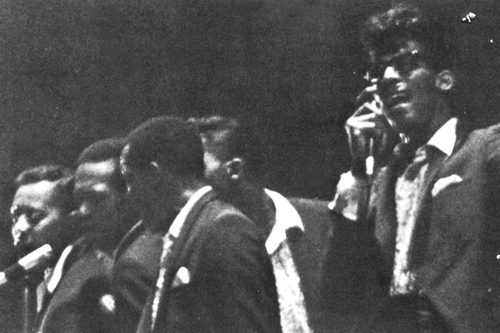
On Feb. 11, 1966, the Temptations played to a sold-out crowd in the Field House. At the time, the group was in its “Classic Five” era, with David Ruffin emerging as a strong lead vocalist on hits such as “My Girl” and “Since I Lost My Baby.”
“Motown acts had become very mainstream by the mid-1960s,” says Gerald Early, the Merle Kling Professor of Modern Letters, “some of them even playing places like the Copacabana, one of the top nightclubs in the country and a club that did not typically book black acts or rock ’n’ roll acts. So, it is hardly a surprise that a group like the Temptations would be playing Washington U. Many universities and colleges would book acts that usually were considered hipper or more youth-oriented than some other venues might.”
Four days before the concert, the Temptations had released their latest single, “Get Ready.” Joel Sanoff, AB ’69, was up front for the show: “To be that close to them as they performed their signature moves was incredible.”
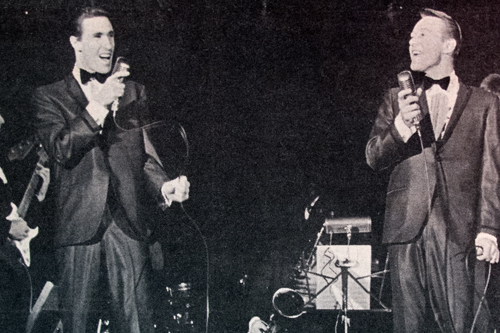
Eight days later, on Feb. 19, the Righteous Brothers came to the university. Mark Edwards, AB ’69, now head coach of Washington University’s men’s basketball team, regularly escorted performers into the Field House as part of his work-study job. During the Righteous Brothers visit, he recalls singer Bill Medley having a tremendous case of stage fright: “It was just me and those two guys in a locker room in Francis Gym. Medley had a 16-ounce Coca-Cola cup full of bourbon that he had to drink before he could go onstage.” Although the show was brief (so much so that it resulted in a contractual dispute), the Righteous Brothers performed hits such as “You’ve Lost That Lovin’ Feeling,” “Soul and Inspiration,” and “Unchained Melody.”
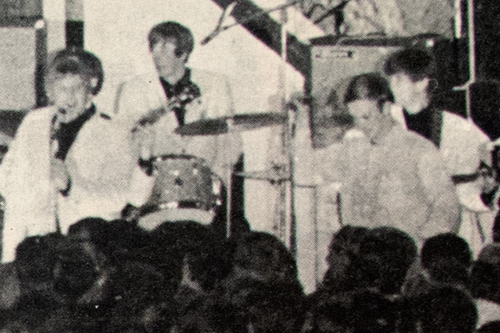
Other notable acts to come to the university in the mid-’60s were the Ike and Tina Turner Revue; the Kingsmen, of “Louie Louie” fame; and, on March 24, 1967, Simon and Garfunkel, who were touring on their album Parsley, Sage, Rosemary, and Thyme.
“Simon and Garfunkel were relatively unknown, at least by me, and I was blown away. Seeing them live at Washington University is something I will never forget,” says Jane Sollogub, BFA ’68. The concert included hits such as “Homeward Bound” and “I Am a Rock,” and was sponsored by the Interfraternity Council and Student Assembly, the precursor to Student Union. Formed in the 1967–68 school year, Student Union would be integral in establishing rock concerts as the norm at the university and remains so to this day.
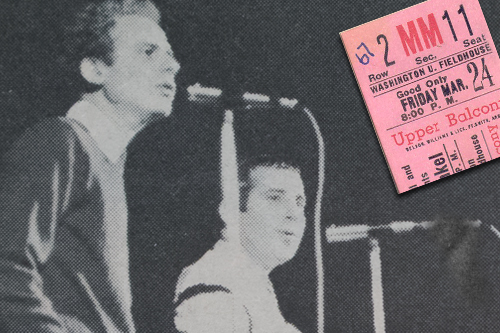
— Student Life ad, November 1968
By the late 1960s, the performances brought in to Washington University took on the atmosphere of a modern rock concert, reflecting the music’s place as a cornerstone of youth culture. “While major venues such as the Kiel Opera House, the Arena and the Fox Theatre brought in large acts, there was not an abundance of rock clubs and smaller concert venues in St. Louis at that time,” says Tony Cabanellas, longtime DJ at KDHX-FM. “Washington University was a place that helped fill that void.”
Publicity for the shows was also very different from that of concerts today. “There was not the luxury of the Internet, and this was before KDHX-FM or the Riverfront Times. People would find out about these concerts from leaflets and posters hanging in music stores or bookstores, from the underground press, and just by word-of-mouth,” says Cabanellas, who as an area high school student in the late ’60s, attended numerous shows at Washington University, and saw many more there as the decades went on.
“Believe in the magic of rock and roll,
believe in the magic that can set you free”
— The Lovin’ Spoonful, “Do You Believe in Magic?”
On Sept. 16, 1967, as the Summer of Love was drawing to an end, the Lovin’ Spoonful visited Washington University’s Field House. The concert had a huge impression on a young James Laverty. Laverty, a videographer based in the St. Louis area, was only 16 when he attended the show. “It changed my world completely,” Laverty says. “It was the first rock ’n’ roll show I’d seen in my life.” As the band, known for hits such as “Daydream” and “Summer in the City,” opened up, and lead singer John Sebastian sang, “Do you believe in magic?” Laverty knew then and there he was a believer, and a lifelong passion for music was ignited. He would go on to play drums in a number of local bands from the ’60s on, and as a photographer, he would later shoot concert pics of such bands as The Who, The Stooges, Jefferson Airplane, Steppenwolf and the Byrds, as well as some of the WU concert photos included here, many published for the first time. Laverty recalls, “It blew my mind, and it all happened at Wash. U.”
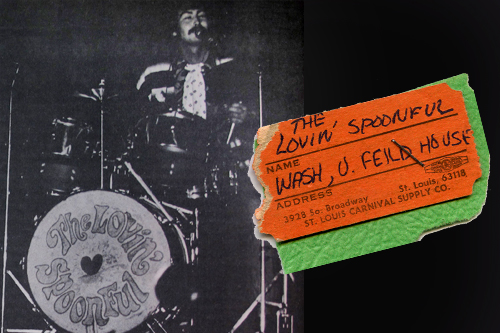
“Stealin’, stealin’,
mama, don’t ya tell on me,
I’m stealing back to the way I used to be.”
— The Yardbirds, “Stealing, Stealing”
On Oct. 28, 1967, The Yardbirds, along with the Ramsey Lewis Trio (“The In Crowd”), played the Field House as part of the university’s Homecoming festivities. The gymnasium there featured two stages in opposite corners of the gym. While the Ramsey Lewis Trio enjoyed a modest crowd, students were already gathered en masse near the Yardbirds’ stage waiting for their show to begin. At this time, The Yardbirds featured guitarist Jimmy Page, who would use a violin bow on his electric guitar while playing blues covers such as singer Jake Holmes’ “Dazed and Confused.”

The Yardbirds show offered glimpses of things to come. After the Yardbirds disbanded the following year, Page would include “Dazed and Confused” on his new band’s debut album; that band was Led Zeppelin, and the song would remain a live staple for the group for years to come. The Yardbirds show at Washington University did have a hitch, though. By varying accounts, either a bottle was thrown past or a bottle was poured on one of the band members’ heads, after which the band angrily left the stage. Fortunately, The Yardbirds were forgiving enough to come back and finish the show.
“Shall we go, you and I, while we can,
through the transitive nightfall of diamonds?”
— The Grateful Dead, “Dark Star”
On April 17, 1969, the Grateful Dead played the Quad. The show included versions of soon-to-be-released classics “St. Stephen,” their cover of “Turn on Your Love Light,” and a 21-minute version of their most famous jam, “Dark Star” — songs that would surface months later on Live/Dead.
“It was springtime and we had our minds on things other than just studying,” says Jan Fitzgerald, AB ’72, MA ’74. “Things were getting very political and exciting with groups from California coming across the country, so there was a lot of anticipation.” Fitzgerald attended with her husband, Keith Fitzgerald, AB ’72, MArch ’74, and the two would go on to see the Grateful Dead many times as the years went on.
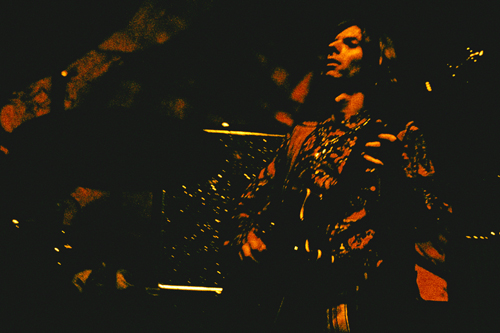
David Backer, BS ’72, who owns a technology consulting business in Massachusetts, recalls: “I was in the library studying when a friend came looking for me, stating: ‘Quick, the Grateful Dead are going to play in the Quad!’ So I grabbed everything, and we ran out. It was with the original lineup, with Pigpen playing keyboards.”
Bob Shelli, AB ’70, emceed the Grateful Dead show. Shelli, who also helped band members with their equipment, recalls that the cowbell mounts on Mickey Hart’s drum kit had broken the previous day and needed repair. At first, he and Hart approached the music department to try borrowing some additional drums (timpani) for the show — a request that could not be granted on such short notice. Then, the two walked down to the architecture school, where Shelli asked a friend, John Reeve, AB ’73, March ’75, if he could weld the set back together. Reeve did, and Hart was able to put down an outstanding performance in the Quad.
At one point in the Grateful Dead’s long show, guitarist and singer Bob Weir remarked on an ominous-looking sky, “This is what they call ’tornado weather.’” It started raining just as the band played “Morning Dew.”
“A little rain came for a while but didn’t bother anyone,” says Jan Fitzgerald. “Everyone was so relaxed, and the show was just a big picnic.”
The show went well into the night. Mark Edelman, AB ’72, adds: “It probably had to do with the cloud cover or something, but it was so loud people were complaining about hearing it in Webster Groves. People called the chancellor to complain.” The concert was abruptly cut short when the police threatened to arrest the band’s road manager if they didn’t stop playing. After a moment of initial disappointment as the show came to a halt, the crowd regrouped with a thunderous burst of applause for the band’s exuberant performance.
“Despite all the computations,
you could just dance to that rock ‘n’ roll station,
and baby it was all right”
— The Velvet Underground, “Rock and Roll”
On May 11, 1969, the now-legendary Velvet Underground played the Field House, with opening act Taj Mahal. While the Velvet Underground would break up in 1970, they became a seminal influence on later bands in the punk, new wave and alternative rock genres. In four albums, the band’s songs explored both urban decadence and the life-affirming sound of rock ’n’ roll.
“The Velvet Underground was fabulous,” says Jan Fitzgerald, “so avant-garde, and so cool and East Coast with the whole Warhol association.” Backer recalls: “I remember the amplifiers were different from what I’d seen other bands use. It was really … loud!”
While introducing their closer, “Sister Ray,” singer Lou Reed quipped to the crowd: “This song is about what happens down in the street … which I’m sure you’re all familiar with.” The song then reverberated in the Field House for a propulsive 28 minutes before the Velvets left the stage.
The Velvet Underground concert is distinctive in that the late Robert Quine, JD ’68, recorded it. Barry Silverblatt, JD ’69, a retired legal administrator and musician in the Bay Area, was Quine’s classmate, bandmate in a local band called Bruce’s Farm, and one of his closest friends during law school. The two went to the Velvet Underground show together. Although the acoustics were less than optimal, Silverblatt thought the band was excellent. “Those were different days. There wasn’t a lot of hand-clapping and stuff, it was more like being zoned out,” Silverblatt recalls. “After the concert, Quine was in seventh heaven. He thought it was great.” Quine moved to California later that year, where he taped additional Velvet Underground shows. His recordings, including a half-hour of the Washington University concert, were commercially released in 2003 as The Quine Tapes.
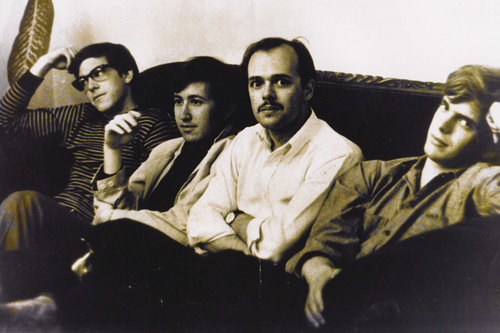
There’s an old saying that only a few people ever really listened to the Velvet Underground, but nearly all of them started a band. Quine was no exception. He would go on to a successful career as a rock guitarist, known for his stinging, incendiary style. Quine, who died in 2004, is listed as one of the 100 Greatest Guitarists of All Time by Rolling Stonemagazine, having played with seminal punk band Richard Hell and the Voidoids among others. And in a remarkable twist of fate, in the 1980s he joined the band of former Velvet Underground lead singer Lou Reed, whom he had seen perform at the university so many years before.
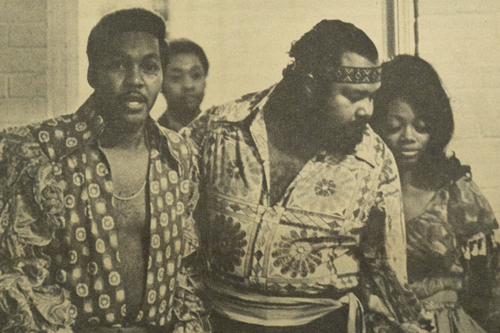
Many other groups came to Washington University during the late 1960s, such as rock legend Bo Diddley, Marvin Gaye, the Fifth Dimension, and the New York Rock Ensemble. Tom Jones, BS/BA ’69, now a successful entrepreneur, recalls Benny Sharp and the Sharpees [the band that was Harold Ramis’ (AB ’66, HPhD ’93) inspiration for the Otis Day and the Knights scene in Animal House] playing at his fraternity. Some alumni remember occasional concerts in Wohl Center featuring local bands, including a Southern band that took up residency in St. Louis for a few months, the Allman Joys. The brothers leading that band, guitarist Duane Allman and singer Greg Allman, would later form the Allman Brothers Band.
Jan Fitzgerald looks back: “Everybody says there’s a soundtrack to our generation, but really the shows took the edge off our angst during a turbulent time. There was the Vietnam War and political issues, and the music was a great leveler. People would just share the music with each other.”
“Right now it’s time to kick out the jams”
— MC5, “Kick Out the Jams”
The early 1970s brought a steady stream of notable rock acts, including the MC5, who played on April 25, 1970, shortly after the inaugural Earth Day. As the Student Union concert chairman at the time, Mark Edelman, AB ’72, recalls a company called National Student Marketing phoned about having Gatorade sponsor an Earth Day concert with the MC5.
“We didn’t have to pay fees, we just had to do the marketing,” Edelman says. “I said, ‘Yeah, we’ll do the show on campus.’”
The experience of helping organize concerts on campus proved invaluable to Edelman, who is now president of Theater League, an organization that brings major Broadway plays to cities across the country. “Mostly it’s the same things — renting a building, getting the staffing, advertising the show, and selling the tickets. It’s what I did then and what I do now.”
The MC5’s raucous, revolutionary rock was well-received during a time when the campus was heavily politicized and tensions over the Vietnam War were at an all-time high. The band played their hit “Kick Out the Jams,” as well as songs from their recently released album Back in the USA. David Backer, BS ’72, recalls the band being really aggressive, and “the audience was really cranked up.” Paul Yamada, AB ’76, MA ’78, remembers the high-energy show coming to an end when MC5 lead singer Rob Tyner motioned for the audience to come onstage with them, prompting the promoters to cut the power.
“Blues were my favorite colour,
til I looked around and found another song
that I felt like singing.”
— Jethro Tull, “Play in Time”
On May 9, 1970, Jethro Tull played the Francis Field House, with the Butterfield Blues Band and Pentangle also on the bill (another National Student Marketing tour package). It was four days after Washington University’s ROTC building was firebombed, and there was speculation that the show would be canceled, recalls James Laverty, although it went on without a hitch. At the time, Jethro Tull was moving away from the blues-based approach that characterized the group’s first two albums, having replaced guitarist Mick Abrahams — a blues purist in the vein of Peter Green or Eric Clapton — with guitarist Martin Barre. The band was touring to promote the album Benefit, which featured less blues and more of Jethro Tull’s signature heavy rock/folk sound. Laverty was able to get backstage and snap photos of the band’s performance that evening, simply by carrying his camera around and looking like he belonged there. Aside from Ian Anderson’s manic flute playing, Laverty remembers the stellar drum solo in “Dharma for One” by Clive Bunker, whom he considers the “best drummer I’ve ever heard.” A year later, Jethro Tull would become a major rock act with the release of their album Aqualung.
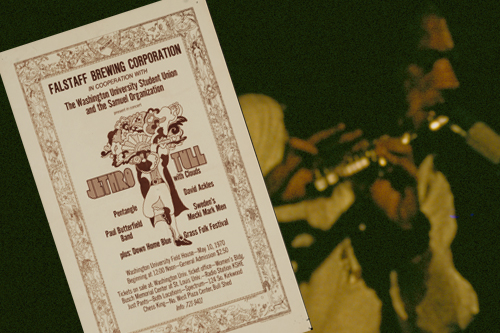
“Well there’s just a little bit of magic
in the country music we’re singin’,
so let’s begin,
we’re bringin’ you back down home where the folks are happy”
— Poco, “Pickin’ Up the Pieces”
A stellar lineup of concerts continued into the 1970s, with acts such as the James Gang, featuring future Eagles guitarist Joe Walsh; Laura Nyro, in a stirring solo performance on a baby grand piano; Richie Havens; Love, featuring the eclectic Arthur Lee; Chuck Berry, in the first of two Quad shows across the years; Tom Waits; Leo Kottke; Ry Cooder; and singer/songwriter Randy Newman. The decade also brought the countrified rock sound of artists such as Emmylou Harris, Little Feat, Jerry Jeff Walker, as well as country-rock pioneers the Byrds and Poco, to campus.
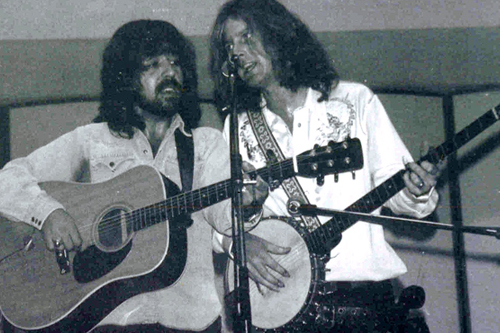
Allen Saxon, MD, AB ’71, particularly remembers the 1971 Poco show. It was the first time he saw the band, and it made such an impression that he has remained a die-hard Poco fan (“Poconut”) ever since. “They really introduced a whole generation of young people to the sophistication and beauty of country music,” Saxon says. “The day after the concert, I went out and bought my first Bill Monroe album.” Saxon, a surgeon in the Chicago area, recently contributed some percussion to Poco’s latest album.
“Dance to the music”
— Sly & the Family Stone
On Sept. 14, 1973, Sly & the Family Stone, brought an exuberant brand of funk to the Quad. David Dorfman, BSBA ’77, then a freshman at the University, attended the show and was impressed not only by the music but also by what the band physically represented — “black and white on stage, male and female playing key instruments, a willingness to deal with the subject of race,” Dorfman says.
“The sensation I recall vividly is the majesty of the scene,” says Dorfman, founder of the David Dorfman Dance Company in New York City and professor of dance at Connecticut College. “I was just starting my first away-from-home academic experience, and here’s this group I’ve only heard on 8-track tape right in front of me in this historic quadrangle. People were dancing and jumping up and down; it was verging on ecstatic.”

So transformative was that show and the group’s music for Dorfman that decades later he created an entire production, Prophets of Funk. Set to Sly & the Family Stone’s music, Prophets of Funk invokes the band’s humanistic spirit through dance, acknowledging the struggles and achievements of “everyday people.”
“A lot of the issues brought up so eloquently, playfully, and sternly in Sly & the Family Stone’s music are still at play. Their politics and optimism said, “Forget the color, tear down these walls, tear down these labels.’”
On Aug. 11, 2011, Prophets of Funk was performed at Lincoln Center Out of Doors with the Family Stone band, a free concert that was part of Dorfman’s mission to “get the whole world dancing,” and a remarkable full-circle from that night in the Quad 40 years ago.
“When I get lonesome the wind begin t’ moan”
— Captain Beefheart and His Magic Band, “Fallin’ Ditch”
As part of the second Open Air Festival in the Quad, rock surrealist Captain Beefheart played on April 21, 1974, closing out what had been an afternoon full of performers. Beefheart’s show featured a hastily assembled band, as his original Magic Band had recently quit en masse, after communal-style living with the tempestuous Beefheart became too much.
Vintage Vinyl co-owner and KDHX-FM DJ Tom “Papa” Ray first heard Beefheart on the radio in 1967 and instantly became a devoted fan. Of the Quad show, Ray remembers, “He had brought with him a swing-style clarinetist, very trained, who at one point went into a pretty ripping ‘Sweet Georgia Brown.’” By the time Beefheart took the stage, many had decided to leave the festival to escape the bad weather. But those who remained enjoyed a unique, albeit transitional, show, with Beefheart performing as howling winds filled the Quad.
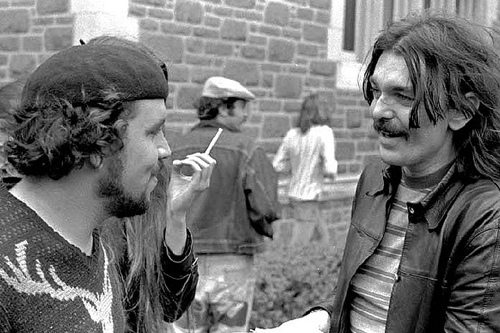
Ray got to meet Beefheart that day in the Quad: “He was very warm, very verbally playful. I had brought a copy of one of his albums, and he inscribed a poem on it for me and signed it ‘Love Ever Gold.’ I was a young man as happy as a pig in mud,” Ray remembers. “At the time, there wasn’t anyone else I would have rather met.”
“It can’t happen here”
— Frank Zappa
On the cold night of Oct. 2, 1977, Frank Zappa played the Quad. By all accounts, it was memorable for all those in attendance, but Zappa’s visit to the university was a life-changing event for one particular student. When Ike Willis, then a sophomore at the university and already a very talented singer and guitar player, heard that Frank Zappa was coming to campus, he asked the show’s organizer, his friend and roommate Steve Kwartin, AB ’79, if he could help out as a roadie or anything else that would get him near the stage.
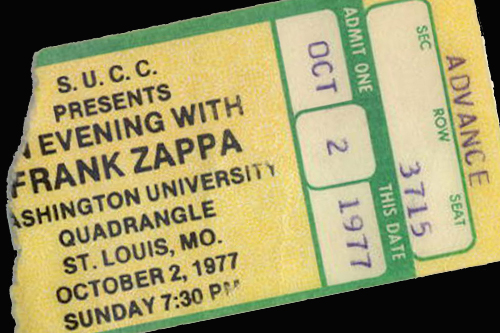
The day of the concert, after the sound check, Kwartin and Willis knocked on Zappa’s door at his makeshift Cupples Hall dressing room. Kwartin introduced Willis as the finest guitar player in the area, so Zappa asked him to play. Kwartin remembers, “So Ike picked up an acoustic and played, and the two of them sat there and played a while longer.” Much later, Willis was sitting in his dorm room one evening when he received a call from Zappa, who had him flown out to Los Angeles for a formal audition. Again impressing with his musicianship, Willis earned the spot as a guitarist and vocalist with Zappa’s band, recording and touring with the band until Zappa’s death in 1993. Willis appeared on albums such as Joe’s Garage and You Are What You Is, and he is currently at work on his memoirs.
“‘Cause I’m gonna make you see
there’s nobody else here
no one like me
I’m special so special
I gotta have some of your attention give it to me”
—The Pretenders, “Brass in Pocket”
Considered one of the greatest debut albums in rock history, The Pretenders blended punk ferocity with pop melodicism. So when the Pretenders came to campus on Sept. 22, 1981, there was excitement in the air. On the day of the concert, Dale Ashauer and friends, with fake press credentials (Surf Magazine), were in the soccer fields near Graham Chapel hoping to meet singer Chrissie Hynde. Ashauer, a sound engineer based in St. Louis, remembers seeing a yellow Chevette cutting donuts in the grass. “It spun around a few times and then flew up to us at a high rate of speed. Windows rolled down, and it’s (Pretenders members) Martin Chambers driving with James Honeyman-Scott in shotgun and Peter Farndon in the back. Chambers said, ‘Ello, mates,’ and they mingled with us for a while.”

Sharon Derry, BFA ’83, was a huge Pretenders fan: “Chrissie Hynde was my style idol then. The way she dressed and wore her hair was my idea of what a cool rock chick should look like.” Derry was then a junior and had just gotten a job at nearby Cicero’s restaurant. “It was my first night on the job, and I asked the manager if I could leave early because I had tickets to the Pretenders. She said yes, which I am eternally grateful for, and I literally ran to Graham Chapel so I could get there in time for the show.”
Chrissie Hynde’s powerful stage presence kept the crowd on its feet as the band roared through songs such as “Precious” and “Brass in Pocket.” Within the next two years, both lead guitarist James Honeyman-Scott and bass player Pete Farndon would die of drug-related causes. Although the band would regroup and go on to even greater success, Wash. U. students had a chance to see the original lineup — the group that forged their unforgettable debut album — perform. “It was just awesome,” Derry recalls.
The ’80s brought more big-name bands to the university, such as the Gang of Four, ska-rockers the English Beat, Joan Jett, prog-rock pioneers King Crimson, blues legend B.B. King, the Violent Femmes, Warren Zevon, reggae stars Toots and the Maytals, the Replacements and Uncle Tupelo
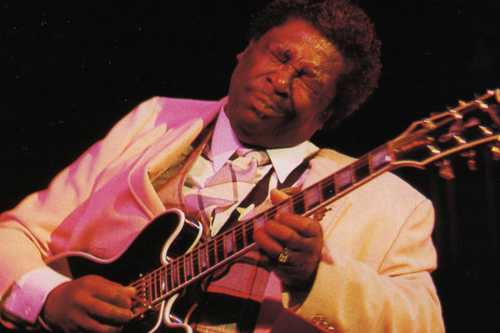
“A perfect circle of acquaintances and friends
Drink another coin a phrase
Heaven assumed, shoulders high in the room”
—R.E.M., “Perfect Circle”
Alternative rock pioneers R.E.M. played Graham Chapel on Oct. 6, 1984, along with opening act the dB’s (who opened with an a cappella cover of “Chapel of Love,” befitting the occasion). Rene Spencer Saller, AB ’89, MA ’90, recalls that R.E.M.’s jangly, murky sound, along with Michael Stipe’s cryptic lyrics, managed to blend well with the less-than-perfect acoustics of the chapel. Touring on their second album, Reckoning, the band had yet to enjoy the tremendous worldwide success their subsequent albums would bring. At Washington University, R.E.M. played songs that would appear in the following year’s Fables of the Reconstruction album, as well as highlights from their first two albums; they even played the theme from TV show Barney Miller, followed by “Chicken Train” by the Ozark Mountain Daredevils (who have also played Wash. U.).
R.E.M. performed two playful encore sets for the receptive Graham Chapel crowd, each consisting mainly of cover songs (e.g., “Paint It, Black,” “In the Year 2525,” [which culminated with Michael Stipe’s inspired paraphrasing of the Max Ehrmann poem Desiderata], and, joined by members of the dB’s to close out the show, “Sloop John B,” “Born on the Bayou,” and “Gloria”). Musician and Euclid Records employee Steve Scariano recalls Stipe singing a great a cappella version of “Moon River.”
Steve Pick of Euclid Records remembers guitarist Peter Buck and the dB’s working up a cover of Television’s “See No Evil” before the show, which they played for the first time that evening and later became a regular encore on the tour.
“The show was great,” Saller says, “but what I remember most was going to an after-party with the band.” In fact, a number of attendees ended up at the party in the Central West End (hosted by a friend of Michael Stipe’s from when Stipe lived in Collinsville, Ill.), where reportedly the beer and conversation flowed.
“It’s gotta be rock ’n’ roll music,
if you wanna dance with me”
—Chuck Berry, “Rock ’n’ Roll Music”
On April 26, 1985, Chuck Berry played the Quad for the second time (the first being in the early 1970s). Joe Edwards, owner of nearby Blueberry Hill restaurant, worked with students to organize the event. He recalls: “It was a wonderful concert, and Chuck was just on fire that night. The student response was phenomenal, and it was gratifying to see another generation get exposed to his live concerts.” Students danced throughout the evening to the high-energy set and sang along to Berry’s rock anthems. “Not only is he the father of rock ’n’ roll, its first great poet laureate,” Edwards continues, “he’s the man who made the guitar a star. He also choreographed the first great rock ’n’ roll stage moves. Everyone there that night saw a magical show.”
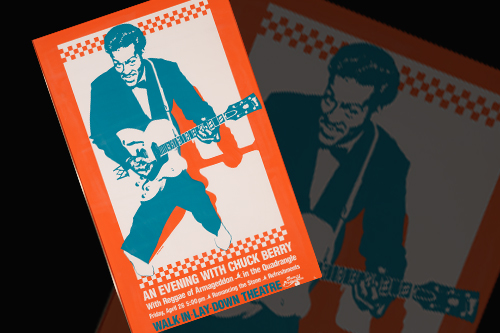
“I never travel far, without a little Big Star”
—The Replacements, “Alex Chilton”
Post-punk legends the Replacements played the Field House Sept. 17, 1987. The Minneapolis band, touring on their Pleased to Meet Me album (for many their swan song, although two more albums were to follow before the band called it quits), was known for its raucous, substance-fueled behavior both on and offstage. As a result, their performances were notoriously sloppy and uneven. Chris King, AB ’88, MA ’89, interviewed lead singer Paul Westerberg for Student Life before the performance. King was a huge fan: “Word guys like me worshipped at Westerberg’s altar. He got everything right, but especially the core identity elements of an angry, desperate, confused, yearning young man in the Midwest.”
King met Westerberg outside the back of the Field House before the show. Westerberg steadily refilled his Jack and Coke during what proved to be an awkward interview. At one point, knowing the band’s affinity for the ’70s group Big Star, King asked Westerberg if the band would consider playing Big Star’s “September Gurls” that night. The answer? “Probably … not.”
True to form, the Replacements’ performance at Washington University was met with mixed reviews, but King fondly remembers Westerberg introducing their first encore: “Well, seeings as it’s September…,” Westerberg muttered as the band started into his request for “September Gurls.” “This guy was a rock god to me,” King says, “and he basically spoke to me personally from the stage while introducing my favorite Big Star song. Obviously, I’m still dining out on that story.”

“Now if it’s to be, if you still believe
come on let’s take the long cut I think that’s what we need
if you wanna take the long cut
we’ll get there eventually”
— Uncle Tupelo, “The Long Cut”
Local band Uncle Tupelo never achieved stardom, but they did herald the alt-country movement in the early ’90s, blending the twang of country with the energy of punk rock. Upon their breakup, certain members of the Belleville, Ill., band would go on to form Wilco, notably Wilco frontman and chief songwriter Jeff Tweedy. Uncle Tupelo played Washington University a few times, including a 1990 show in Holmes Lounge that Liam Otten, MFA ’91, attended. “I remember the band going into this stop time rock. The music was great but no one could figure out how to dance to it,” Otten says.
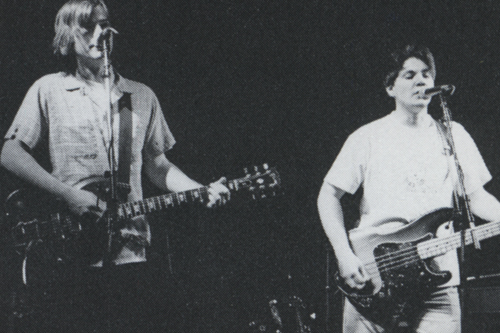
In 1991, Uncle Tupelo was asked to open for British working-class rocker Billy Bragg at Graham Chapel. This was significant because it was the first meeting of Bragg and Uncle Tupelo’s Jeff Tweedy. Later, when folk-icon Woody Guthrie’s daughter, Nora, came to Bragg with a handful of lyrics her father had written, hoping to have them put to music, Bragg called on Tweedy, then with his post-Tupelo band Wilco, to collaborate with him. The resulting album, Billy Bragg & Wilco’s Mermaid Avenue, was one of the most acclaimed albums of 1998. A documentary about the collaboration, Man in the Sand, was released the following year. Of course, without their fateful meeting at Washington University years before, the collaboration might never have happened.
“Let’s turn up our amps
the way that we used to
without a plan”
—Yo La Tengo, “Big Day Coming”
As alternative rock flourished in the ’90s, Wash. U.’s Gargoyle, a nightclub for students located in Mallinckrodt Center, played host to acts such as Stereolab, Babes in Toyland, Bikini Kill, and the Jesus Lizard. One unforgettable show in 1993 featured alternative rock purveryors Yo La Tengo. When the band, consisting of husband/wife duo Ira Kaplan and Georgia Hubley as well as James McNew on bass, came to the Gargoyle, they had recently released the extraordinary album Painful (which would be the first of three consecutive albums to earn a 5-star, classic rating from Rolling Stone). It was also the beginning of a beautiful relationship, as Yo La Tengo would come back to the university again in 1995 and 2004.
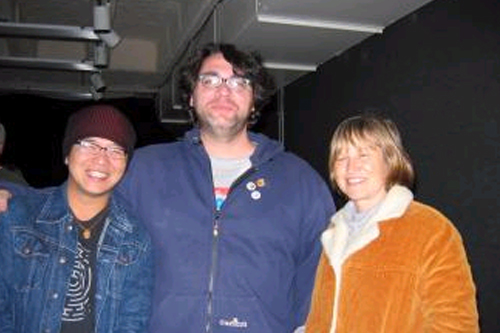
Drake Weisert, AB ’96, now with the State Department, remembers: “The show was something special, mainly because of the way it started. Drummer Georgia (Hubley) came out by herself, picked up a guitar, and started tinkering around with it and getting feedback. She kept building the sound until it was absolutely huge, and everyone was staring with their mouths open. It was the first time I’d ever heard feedback played like an instrument. She put the guitar down (as it was still wailing), got behind the drum set, and started banging out a beat. Then the other two members came out and started things in earnest. The whole show was raw and bold and left the crowd mesmerized.”
“I have a secret to tell
from my electrical well”
— They Might Be Giants, “Birdhouse in Your Soul”
During the ’90s, Team 31’s WILD (Walk-In Lay-Down) brought rousing performances to the Quadrangle, including two from offbeat They Might Be Giants, whose 1990 album Floodwent platinum and produced hits such as “Birdhouse in Your Soul” and “Istanbul (Not Constantinople).” A Tribe Called Quest, De La Soul, Widespread Panic, Pere Ubu, and Guided by Voices also played the Quad. Fast-forward to the ’00s and ’10s, and concerts included George Clinton and the P-Funk All-Stars, the Roots, Outkast, Live, the Cold War Kids, and the Black Keys.
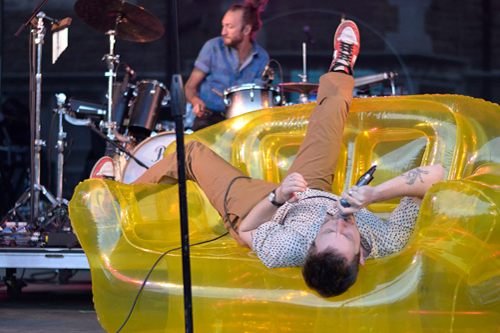
In looking back, it becomes clear that these performances, and many others, often thrilled and even inspired those in attendance. And for some of the performers themselves, playing Washington U. proved memorable. Midway through U2’s sold-out Busch Stadium concert in 2011, lead singer Bono grabbed a tattered piece of paper from his pocket. It was the set list the band had played on campus in April 1981. “Thanks for sticking with us. We’ve been here before,” recalled Bono to the crowd. “Unusual little venue, at the Graham Chapel, Washington University.”
Bono then read the list, noting that the encores were the same songs as the first three in their set — “11 O’Clock Tick Tock,” “The Ocean” and “I Will Follow.” The budding U2 had played everything in their repertoire and could only repeat songs for an encore. “You’ve heard this before,” Bono said that night to the insatiable Graham Chapel crowd. “Wanna hear it again?”
As every year brings the promise of another great show, Washington University students continue to both organize and enjoy what has become an impressive tradition. Remembering his own concert-going experience at the university, Vintage Vinyl’s Tom “Papa” Ray says succinctly: “It was always a groove.”
Ryan Rhea, AB ’96, MA ’01, is an editor in the university’s Public Affairs Office.
Special thanks to Sharon Derry, Joe Edwards, Jan Fitzgerald, John Forrester, Steve Kwartin, James Laverty, Bob Shelli, University Archives, and all those who took the time to share their memories with Washington Magazine.
